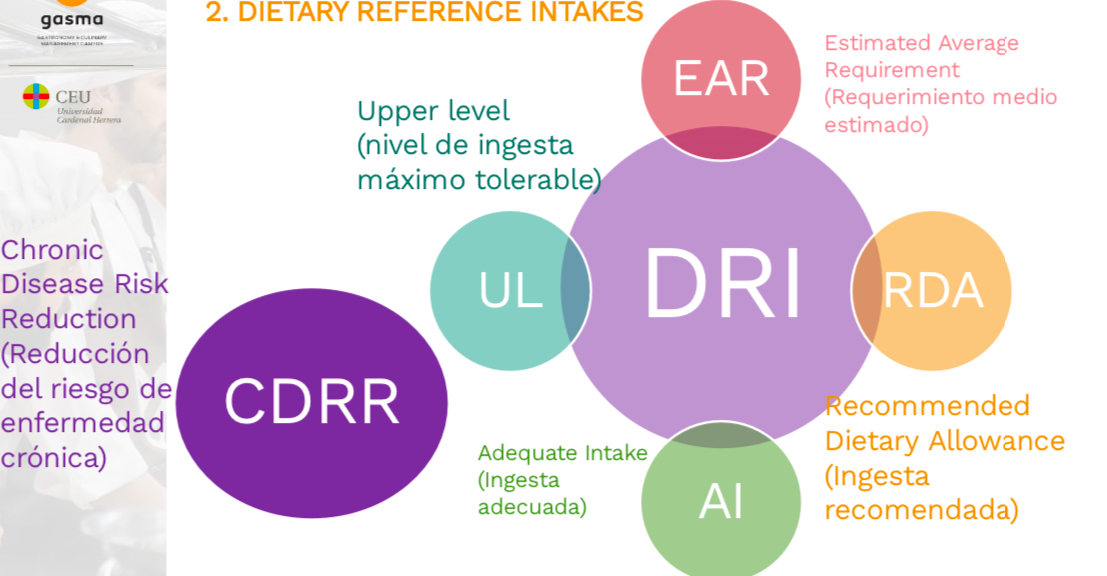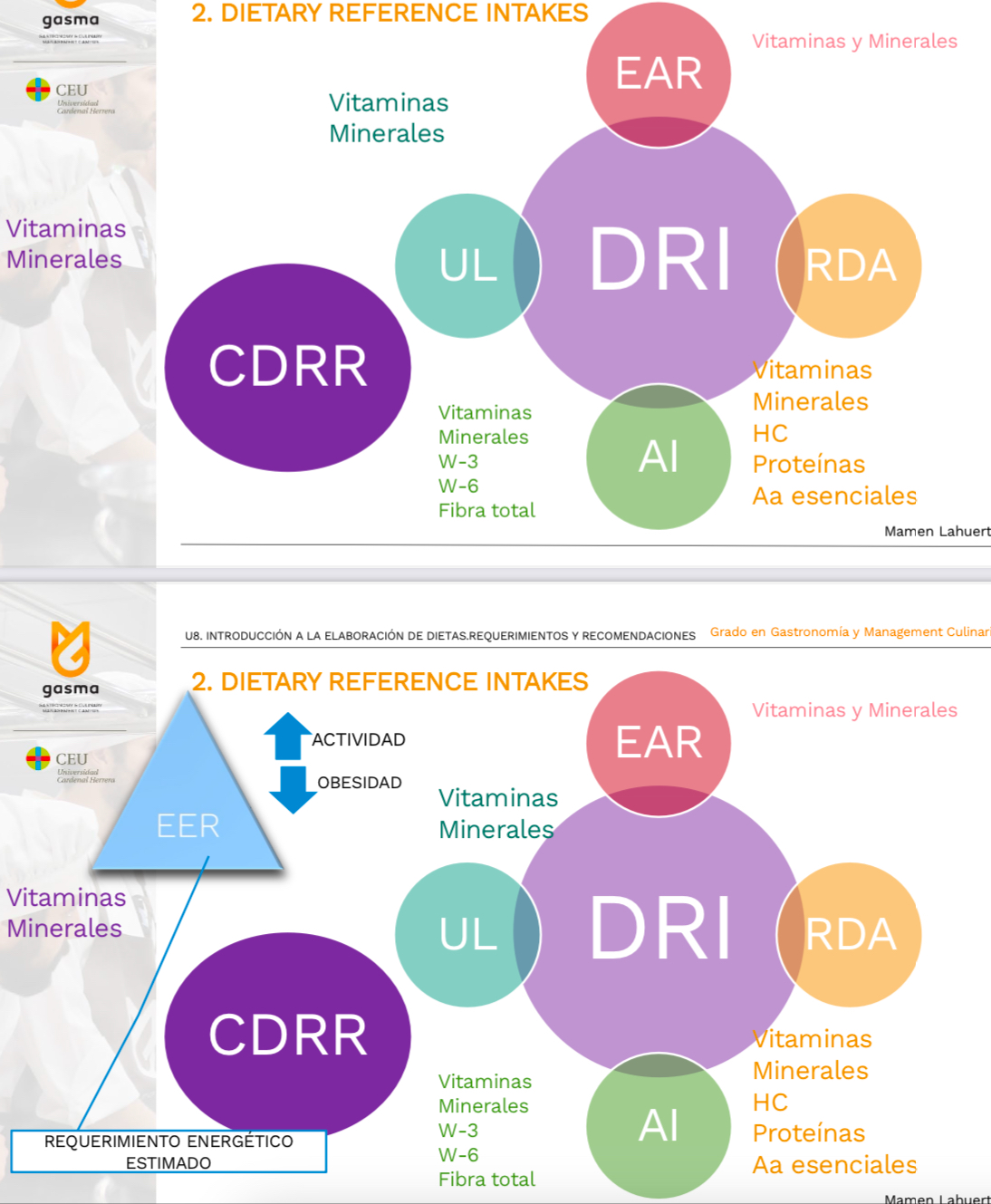unit eight - introduction to diet planning
1/29
There's no tags or description
Looks like no tags are added yet.
Name | Mastery | Learn | Test | Matching | Spaced |
|---|
No study sessions yet.
30 Terms
general principles
• Definition: The amounts of nutrients an individual needs to regularly consume to maintain a healthy nutritional state and prevent disease.
• Variability: Nutritional needs vary widely among individuals.
• Terminology:
• For populations, the term “recommended intakes” is used instead of “nutritional needs.”
Nutritional recommendations
Nutritional recommendations are intake levels of energy and essential nutrients that a committee of experts, consider adequate to meet the needs of the greatest part of the healthy individuals of the population to which they allocate.
• Levels of energy and essential nutrient intake established by expert committees to meet the needs of most healthy individuals in a population.
• Nutrient recommendations are set two standard deviations above the population’s average needs, covering 97.5% of individuals.
• Energy recommendations are based on the population’s average needs to prevent obesity.
History of Dietary Guidelines
1941 RDA (Recommended Dietary Allowance)
1997-2005 DRI (Dietary Reference Intake)
2019 CDRRI (Chronic Disease Risk Reduction Intake)
2024 Future updates pending
Dietary Reference Intakes (DRI)
• Definition: Not minimum or optimal intakes, but safety ranges to prevent deficiencies and chronic diseases.
• Purpose:
1. Plan and evaluate diets.
2. Assess food as nutrient sources.
DRI components
1. EAR (Estimated Average Requirement): Median intake that meets the needs of half the population.
2. RDA (Recommended Dietary Allowance): Intake covering 97–98% of individuals.
3. AI (Adequate Intake): Used when no EAR is available.
4. UL (Upper Limit): Maximum intake without adverse effects.
5. CDRR (Chronic Disease Risk Reduction): Intake associated with lower chronic disease risk.
dietary reference intakes

dietary reference intakes

UL: Upper Limit
• Definition: Maximum daily nutrient intake unlikely to cause adverse effects for most individuals based on age and sex.
• Risk: Exceeding the UL increases the likelihood of negative health outcomes.
CDRR: Chronic Disease Risk Reduction
• Definition: Intakes associated with reduced chronic disease risks.
• Challenges:
• Chronic diseases are complex, with nutrients being one of many risk factors.
• Evidence often comes from studies that make it difficult to establish causality.
Comparison Between RDA and DRI
1. DRI encompasses multiple values for each nutrient (EAR, RDA, AI, UL, CDRR).
2. Objectives:
• Prevent nutritional deficiencies and malnutrition.
• Reduce risk of chronic degenerative diseases.
3. UL sets maximum intakes for each nutrient using toxicological criteria.
Interest in the intake of non-nutrients —> health benefit; the choline, prebiotics, probiotics and antioxidants
• Review the DRI whenever new scientific advances Available about a nutrient so recommend it, without wait for fixed periods of time
Nutritional Needs and Macronutrient Recommendations
Carbohydrates
• Primary energy source for the brain.
• Recommendations:
• Total Contribution: 45–65% of daily energy intake.
• Simple Sugars: <10% of total energy.
• Dietary Fiber: 25–35 g/day.
Nutritional Needs and Macronutrient Recommendations Lipids
Lipids (Fats)
The main importance in the contribution of lipids lies in the essential fatty acids (w3 and w6)
In the infant and the elderly are also essential:
Arachidonic, eicosapentaenoic (EPA) and Docosahexaenoic (DHA).
Your contribution to the total E = 20%-35% (depending on age and source)
AGS < 10%
AGP = 6% - 11%
AGM = 15%-20%
W-3 = 0,6%- 1,2%
W-6= 5 - 10%
Colesterol < 300mg/day
Nutritional Needs and Macronutrient Recommendations Proteins
• Key structural components of all cells, enzymes, and hormones.
• Needs vary with age, growth, and physiological state.
• Recommendations:
• Total Contribution: 10–35% of daily energy intake.
• Infants: 1.5 g/kg/day.
• Adults: 0.8 g/kg/day.
• Pregnancy/Lactation: 1.1 g/kg/day.
• Origen
Nutritional Needs and Macronutrient Recommendations Water
• Needs depend on:
• Extrinsic Factors: Physical activity, environmental temperature.
• Intrinsic Factors: Sweating, electrolyte balance.
• Includes water from foods, beverages, and drinking water.
• Recommendation: 1–1.5 mL per kcal/day.
VITAMIN D rec
• To establish your recommendations, the factors that affect your body synthesis
• Recommendations between countries can be very different.
• Vitamin D requirements are modified by age and Special situations
• Like g of cholecalciferol or IU of vitamin D
• EAR = 400 IU (10µg)
• RDA = 600 IU (15µg)
VITAMIN C rec
• Values depend on age and sex, their requirements are increased in gestation and lactation.
• In consideration factors such as its limited absorption in the intestine, vitamin losses during treatment usual of food.
• RDA Female = 75 mg /day
• Male RDA = 90 mg/ day
• RDA Smokers = + 35mg/day
Calcium rec
Purpose: maximum retention of the mineral, in each of the Age groups
• Growth, avoid risk, osteoporosis in the elderly.
• Absorption —> factors
• Deficiencies and excesses
• RDA Growth and pregnancy = 1300mg /day
• Adult RDA = 1000mg /day
• RDA > 70 to = 1200mg/day
Iron rec
Iron hemo and not hemo
• Absorption. (facilitated or prevented)
• The nutritional status of the individual modifies his bioavailability, So that in situations of greater need it increases.
• RDA female = 18mg/day
• Man RDA = 8mg /day
USEFULNESS OF RECOMMENDED INTAKES
• The evaluation of the nutritional status of a population, the doses of nutritional supplements and special diets, the relationship between the intake of nutrients and the manifestation of diseases.
• A country's public health to establish its policies nutritional and food guides or plan health programs related to the diet.
• In the design of fortified or supplemented foods, as well as different nutritional supports aimed at covering the Possible deficiencies in a given population or Complement traditional foods; advertising and Food labeling, because it allows to value the food In a diet not only for its nutrient content but in Relation to needs.
• Dietary advice and diet planning
• Assessment of adequate dietary intake avoiding deficiencies and excesses, and allowing the complementarity of the various goods that within 5-10 days cover, globally, the nutritional needs of the individual or population to which they are directed.
Nutritional Evaluation of a Diet (Menu)
To determine the energy and nutritional value of a quantity of food or drink (figures expressed in grams for solids and in milliliters for liquids) the amount of food is multiplied by the value of the nutrient that appears in the Composition Table of food and divided by 100.
Key Principles
1. Balance:
• Macronutrients should align with dietary guidelines.
2. Adequacy:
• Include sufficient micronutrients to meet DRI values.
3. Moderation:
• Limit added sugars, saturated fats, and sodium.
4. Variety:
• Include diverse foods from all food groups.
Steps for Nutritional Evaluation
1. Analyze the Nutritional Composition of Meals:
• Use nutritional databases to determine macronutrient and micronutrient content.
2. Compare Against Guidelines:
• Ensure the menu meets energy and nutrient requirements for the target population.
3. Identify Gaps or Excesses:
• Adjust portion sizes or food choices to optimize balance.
4. Assess Acceptability:
• Consider cultural, personal, and economic factors.
Introduction to Designing a Healthy Diet
- The different stages of life lead to different development
- Different nutritional and energy requirements
- Physiological differences = different choice
- WATCH OUT!!! COLLECTIVE RESTORATION
- Food
- Textures
- Culinary techniques
- Nutrients
Healthy Plate: Beverages
• Water is the drink of choice.
• Hydration Needs:
• Not everyone needs 2L of water per day; the guideline is 1.5ml per kcal/day.
• Options for Variety:
• Infusions, carbonated or non-carbonated flavored water, homemade sugar-free drinks, broths, etc.
• Occasional Beverages:
• Light/Zero sodas, alcohol-free beer, or 0.0% beer can be consumed but not daily—preferably in social settings.
• Avoid as Much as Possible:
• Alcohol, sugary sodas, juices, and milkshakes.
Healthy Plate: Fruits and Vegetables (50% of Daily Intake)
Fruits:
• Recommendations:
• Vary colors to include different vitamins and antioxidants.
• Prioritize seasonal fruits.
• Aim for at least 3 servings per day, including one high in vitamin C (e.g., citrus, strawberries, red berries, kiwi).
• Serving Size:
• 1 medium piece, 1 handful of small fruits, or 1 slice approximately 2–3 fingers thick.
Vegetables:
• Recommendations:
• Vary types and choose seasonal options.
• Minimum: Twice daily, always included in lunch and dinner.
• Eat raw vegetables at least once a day to preserve vitamins (e.g., cold soups, crudités).
• Keep convenient options stocked: frozen, boiled, roasted, or canned vegetables.
Healthy Plate: Proteins (25% or 1/4 of the Plate)
Legumes:
• Examples: Lentils, chickpeas, beans, peas, soy, tofu, edamame.
• Frequency: At least 2–3 days per week, even in summer (e.g., salads, stir-fries, falafel, tofu).
• Recommended Weekly Intake: 4–7 servings per week.
• Serving Size:
• 60g of dried legumes (1 closed fist or 3–4 tablespoons) or 8–10 tablespoons of cooked legumes.
Fish (White and Oily):
• Frequency: At least 3–4 days per week, more than meat.
• Include low-fat shellfish and mollusks (e.g., mussels, clams, octopus, squid).
• Fresh or natural canned options are acceptable but do not replace fish consumption.
• Serving Size: Slightly larger than the palm of the hand (125–150g).
Meat and Meat Products:
• Consume less frequently than fish and legumes.
• Recommendations:
• Choose fresh, lean meats like poultry or rabbit.
• Limit fatty cuts (e.g., ribs, sirloin) and organ meats.
• Restrict consumption of processed meats (e.g., sausages, bacon, deli meats) even if made from turkey.
• Serving Size:
• Size of the palm of the hand (100g) or 2 thin slices of turkey, ham, or 2 tablespoons of diced ham.
Label Recommendations for Meat Products:
• Look for processed meats with a high percentage of meat (close to 100%).
Eggs and Nuts:
1. Egg Selection:
• Choose eggs labeled as “0” (organic) or “1” (free-range).
2. Consumption Tips:
• Include as a snack or as an ingredient in recipes.
• Raw Nuts (Unsalted): Consume with the shell to manage anxiety-related snacking tendencies.
3. Serving Size:
• Closed fist-sized portion for nuts such as almonds, hazelnuts, walnuts, pumpkin seeds, or cashews.
Dairy or Vegetarian Alternatives
1. Not Essential:
• If consumed, limit to 1–2 servings per day and prioritize quality.
2. Recommendations:
• Whole or semi-skimmed milk.
• Plant-based drinks without added sugar and fortified with vitamin D.
• Unsweetened natural yogurt, unsweetened kefir, fresh or soft cheese.
3. Serving Size:
• 1 glass of milk or kefir, 2 yogurts, or 2 slices of cheese.
Healthy Plate: Whole Grains and Tubers (25% or 1/4 of the Plate)
1. Frequency and Portion Control:
• Can be consumed daily, but adjust portions based on physical activity to avoid excess.
• Remember: “It’s not rice with vegetables; it’s vegetables with rice!”
2. Grains and Tubers to Include:
• Opt for whole-grain versions of rice and pasta (except for traditional dishes like Sunday paella).
• Diversify with sweet potatoes, cassava, oats, spelt, millet, bulgur, buckwheat, kamut, etc.
3. Serving Size:
• For bread: 4–6 finger-widths of baguette for toast, or 2–3 finger-widths when eaten with meals.
• 60–80g of raw grains (e.g., rice or pasta): Closed fist-sized portion when raw or a glass-sized portion when cooked.
• For tubers like potatoes: Size of a closed fist.
Tips for Identifying True Whole-Grain Bread
• Check ingredients: The label should state “whole-grain (x) flour.”
• Avoid products labeled as “(x) flour + bran,” as they are refined grains with added bran.
Healthy Cooking Tips
1. Cook Healthy, Tasty, and Varied Meals:
• Focus on balanced and nutrient-dense options.
2. Adapt to Real Flavors:
• Reduce reliance on artificial flavor enhancers.
3. Plan Ahead:
• Organize meals to avoid impulsive, unhealthy choices.
4. Mindful Use of Salt:
• Limit salt and explore alternatives like herbs and spices.
5. Practice Mindful Eating:
• Pay attention to the preparation and enjoyment of meals.
6. Recommended Culinary Techniques:
• Steaming, grilling, roasting, and baking for healthier results.